Harmonic Evolution Part 2
By Richard Merrick
Back to PART 1
5. Harmonic Patterns in the Human Body
A larger pattern does indeed appear to be guiding evolution. When we take both the Blackman spectral analysis and Reflective Interference Model and compare them proportionally to Leonardo da Vinci’s Vitruvian Man illustration, we find a number of correspondences between the resonant gap pattern and key locations in the human body (Fig 14).
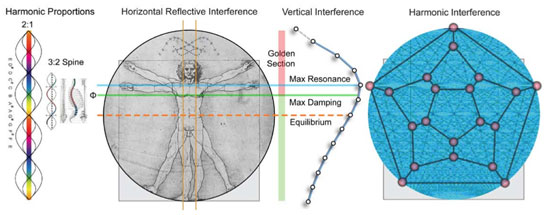
The point of maximum resonance (a 5:3 ratio) aligns precisely with the lower throat and top of the heart. The point of maximum damping (the golden ratio) then aligns with the lower heart. Together, these two locations correspond to the pumping action of the heart as it contracts in a twisting or wringing motion from top to bottom. Arms occupy this same resonant region, branching outward along the wide open pattern of gaps. This cannot be only the result of natural selection or random mutation.
Other correspondences include a pronounced stripe aligning with the top of the Vitruvian square and several gaps aligning with the brain, navel, perineum and knees. Based on these alignments, it seems undeniable that the human body is structured just like two musical tones diverging over an octave from the toes out to the fingertips. Thus, if the geometry of life is a function of harmonic resonance like a musical octave – then, the spine represents an axis of resonance in the body, partitioned into 24 discrete harmonic frequencies.
To this point, if we take the radius of the circle to be 2π and then align one full cycle of a harmonic standing wave with the navel, the fifth harmonic (a 3:2 proportion) can be found to match the curvature of the human spine – exactly. More amazing than this, the location and spacing of the seven tones of a musical major scale align with the seven Hindu chakra locations in the body. Even the traditional chakra colors align to these locations when the perineum (at the bottom of the torso) is assigned red at the bottom of the visible light spectrum. Obviously, someone understood harmonic interference patterns and their presence in the body a long, long time ago.
From here, we can reverse engineer the basic harmonic framework of the body using the physics of a circular cymatic resonance container. We begin by following a series of concentric damping rings spaced by the golden ratio converging inward toward the center of the body (Fig. 15). These rings represent the calmest and most stable locations in a circular standing wave.
At the outermost ring, there is 100 percent damping and no resonance, but as we move to the next two rings, appendages appear followed by a space for the torso. At the fifth ring in, a split occurs at the solar plexus, creating a new point of symmetry for the upper and lower halves of the torso.
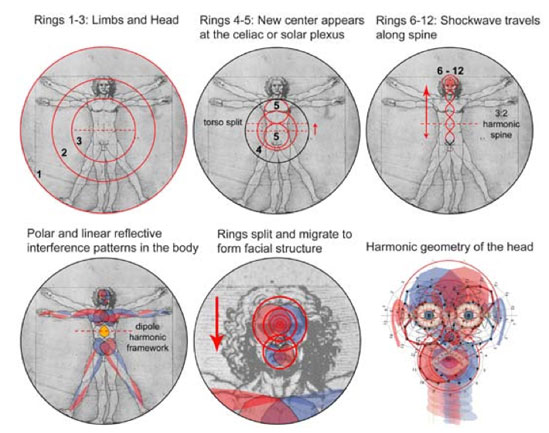
From the solar plexus, a 3:2 harmonic shockwave (fifth harmonic wave) apparently travels along the spine to the brain, creating a dipole nervous system. The head itself is dimensioned by another set of seven rings with the seventh ring migrating tangentially downward to define the basic geometry of the face. Within this ring set, Polar Reflective Interference patterns paired with a few simple waveforms can account for virtually every facial feature – from the coronal geometry of the brain down to the skeletal structure of the face. Even the tongue seems to fit perfectly inside the almond-shaped mandorla region in the lower interference pattern. When we take a closer look at the geometry of the brain itself, we find more compelling evidence of spherical harmonic patterns guiding the evolution of perception and the five senses (Fig 16).
The brain begins as a single ring set at the end of the spinal column that resonate at a 90-degree angle from the temporal lobe (as cosine) to form the frontal lobe (as sine). This frontal ring set then continues by taking a right angle turn down, phase shifting another 90-degrees from the frontal lobe ring set (as sine) into the mouth-jaw region (as cosine). In this way, the geometry of the head completes a half-twist or π-radian phase shift from cosine harmonics to sine and back to cosine. This half-twist phase shift between three sets of harmonic rings would explain how our face came to be cross-wired to our brain.
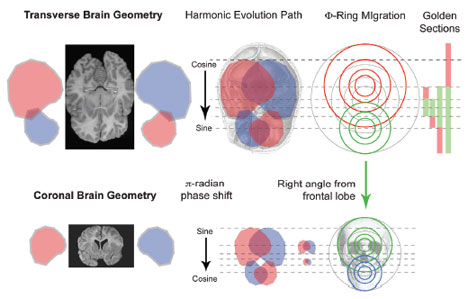
But the twisting does not stop there. It appears to continue spiraling inward, opening up the mouth to the nasal passage and displacing inner cells forward, carving out the sinus cavity and forming the peculiar shape of a nose (Fig. 17).
Our head is indeed a fifth appendage that winds around our ear canal into the jaw hinge, clenching into itself like a chambered nautilus instead of unfolding as our arms and legs do. If it were unwound, it would form a perfect star geometry with the body that sequentially hears, sees, tastes, smells and feels as it narrows to a point. Top this off with the pentagonal cranium found in every human infant and it becomes pretty clear that our body evolved as a pentagon in the anterior and dorsal dimensions and as a Fibonacci spiral in the lateral (or side) dimension of the head, unfolding into the sinusoidal wave of the spine.
So it is through a brief geometric analysis of our bodies that we can understand how life evolved according to harmonic principles – not merely through natural selection and accidental mutation as commonly believed. The same Reflective Interference Model is repeated over and over at different scales and orientations in the body, spiraling and twisting at right angles into itself to fill the gap left by the previous pattern. This is our body’s fractal logic.
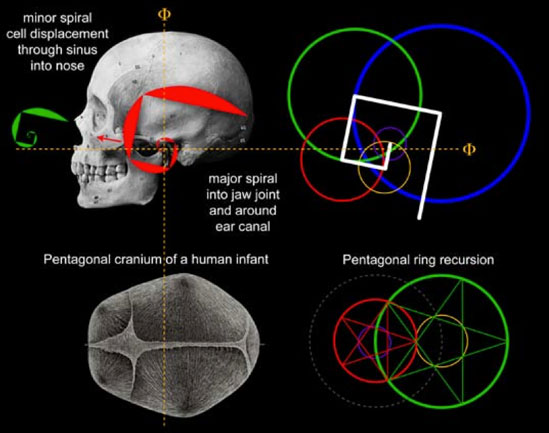
But of course, the body does not begin from the outer ring and work its way inward – rather, it starts somewhere in the innermost ring (conceived as an idea, perhaps) and unwinds outward. If we follow the rings in reverse order from the inside-out, we find that growth must begin at the center of the brain where resonance is greatest, unwinding into the spine and splitting into an upper and lower torso under damping pressure of Ring 5 (seventh ring from the center). From here, it extrudes outward into five appendages, each with their own five appendages to touch the world.
The significance of five in all this can be found in the damping pressure of the fifth harmonic wave (crystallized into the 3:2 ‘perfect fifth’ of the spine) in slowing atomic resonance and stopping cell growth. It is this very special harmonic that generates the golden ratio Φ at the center of the body’s spiral by crossing or interfering with its fundamental resonant frequency. This is expressed by the equation for the golden ratio as Φ = (1 + √5) / 2).
6. The Harmonic Lattice
Based on the previous discussion, a Harmonic Lattice is now proposed as a resonant container for organic growth that guides evolution. Using an outer orbital radius of 2π, a grid of mutually orthogonal standing waves can be superposed over concentric Φ- spaced damping rings to create an organic Hilbert space. This lattice is the only arrangement of standing waves in two dimensions that can sustain field resonance. (Fig. 18)
To match the harmonic proportions of the human body, each ring is assigned a frequency multiple corresponding to its ring number. For example, Ring 1 is assigned the fundamental frequency, Ring 2 the harmonic frequency of 2X, Ring 3 the frequency 3X and so on. In this way, growth is represented as an inside-out patterning process governed by twelve cylindrical harmonics shifting in step- wise fashion from maximum resonance to maximum damping.
Using this recursive lattice, we can calculate the squaring of the circle represented by the Vitruvian model as a balance of resonance and damping. Beginning with radius R of Ring 1, equal to 2π = 6.28318, the area of the Vitruvian circle is:
ACircle = πR2 = 124.0248
The area of the Vitruvian square (according to Vitruvius) can then
be calculated as the golden section of R as:
HSquare = R x Φ = 10.1664
ASquare = HSquare2 = 103.3555
Taking the ratio of the areas of the circle and square we have:
ACircle:ASquare= 124.0248 ÷ 103.3555 = 1.1999 ≈ 1.2 = 12:10 = 6:5 Circle Square
This result is consistent with the 12:10 ratio of carbon-water resonance and the dodecahedral helix structure of DNA.
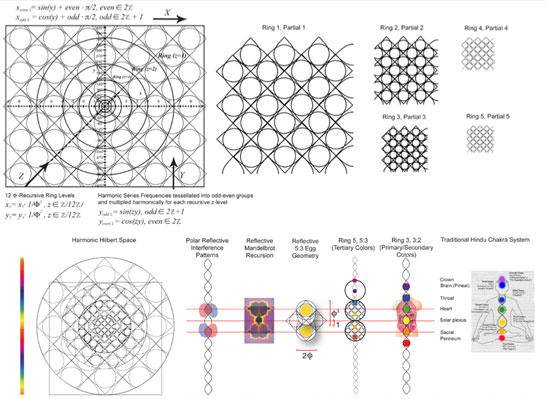
We see here that ‘squaring the circle’ is really the closest possible ratio of 12 to 10, making the Vitruvian model of the human body a 12-fold ringed recursion divided by 10. Indeed, this is the only way to balance π-resonance against Φ-damping in the orthogonal standing wave model of the Harmonic Lattice. As the penultimate harmony of space and time, the 12/10 or 6:5 ratio in the human body is an embodiment of the balance between spherical energy and cubic space – a circle and square:
π : Φ2 = 1.1999 ≈ 1.2
From this, we can calculate the precise point of balance in the growth of the human body where resonance transitions to damping.
Since it was at Ring 5 where the torso splits to create a new center at the celiac (or solar plexus), we begin by calculating the surface area of Ring 5:
ARing 5 = π(R * (1/Φ)4 )2
ARing 5= π(0.9167)2
ARing 5= 2.64
On either side of this number we find the outermost ‘squared circle’ proportion of π : Φ2 = 1.1999 (or 1.2 rounding up) and its reverse-squared proportion of π2 : Φ = 6.099 (or 6 rounding down). When the area of Ring 5 is taken as a proportion to each of these square proportions and then multipied together, we find the point of transition where damping overcomes resonance in a standing wave to be:
Torso Split = (ARing 5 : ⎡(π : Φ2)⎤ x (⎣π2 : Φ⎦ : ARing 5)
Torso Split = (2.64 : 1.2) x (6.0 : 2.64)
Torso Split = 5
Not surprisingly, the point of balance in the Vitruvian model (and in the human body) is at a 5:1 proportion. The reversal to square Φ (replacing square π) represents water’s pentagonal damping pressure against carbon-12 resonance. This is the math behind the previously unexplained split in the human torso.
At and below the fifth ring, we find π and cyclic harmonic proportions resonating to drive growth – but, as we reach the fifth ring, Φ (= (1 – √5) / 2) becomes dominant to damp inner resonance and gradually slow cell growth in the outer four rings. Growth stops altogether when cellular resonance reaches zero at the toes and fingertips.
In the body, this transition at Ring 5 must be the defining event that generates the 3:2 spine and nervous system. The spine, measuring a half-period or π-radian in length, is then partitioned into 24 discrete vertebrae (as the proportion 24 : 10), each scaled proportionally by π/24. And, since 10π/ 24 ≈ Φ3 : 2Φ, each group of ten vertebrae closely match the proportion of a golden egg – cubed in its length and doubled in its width.
Parallel with the spine, the heart, celiac and uterus also align with the 3:2 anti-nodes of the spine’s sine wave, fitting perfectly inside the lattice of Ring 3 (Fig. 19). The overall structure of the torso is triadic with vascular branching along a vertical sinusoidal flow. The analysis suggests that cells entrain along electromagnetic paths during growth and evolution, crystallizing coherently in accordance with the proposed Harmonic Lattice.
Additional work is required to parameterize the lattice for deformation in order to accomodate the morphological adapation found in the fossil record and living organisms. Further correlation with the genetic code is also needed to adequately explain harmonic entrainment in terms compatible with the existing fields of organic chemistry and molecular biology. Doing so could have a profound effect on the direction of medical research, including computer modeling and even the engineering of entirely new species.
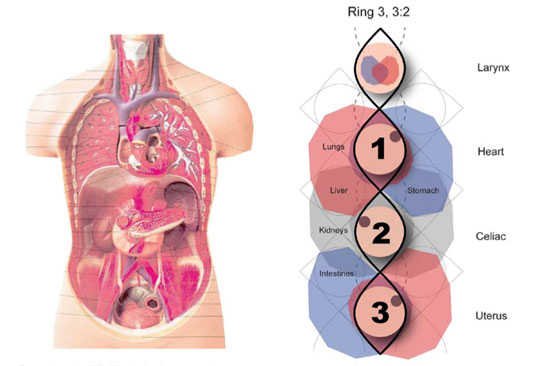
7. Suggestions for Additional Research
Since harmonic physics is universal to all things, the Reflective Interference model and Harmonic Lattice can be applied to any number of other fields of study with surprising results. Topics normally not associated with evolutionary theory, such as psychology, cosmology, sociology, music and computer simulation, can all benefit. Harmonic models offer a powerful cross-disciplinary platform capable of connecting diverse findings while expanding the scope of evolution into these fields. Here are a few examples.
The solar system as harmonic container
By definition, Darwinian theory assumes that evolution began with the very first organism, or at least the earliest known fossil. But if harmonic physics was at work at that time guiding the growth and evolution of life, why would it not also have guided the development of the Earth and our solar system? Could there be a cosmological equivalent to harmonic evolution in life?
As it happened, our solar system evolved according to the same harmonic principles in life. For example, the solar system can be modeled as a geometrical pattern without using any physical measurements whatsoever and within a cumulative average variance of less than -0.04 percent. Beginning with Mercury’s orbit, we simply calculate each successive semi-major axis as a multiple of the constant 1.6877, equal to 39(1/7) or one-sixth the semi-major axis of Eris divided by 1,000 (Fig. 20).
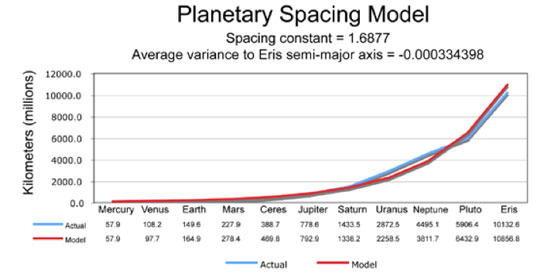
While only an approximation, the actual orbits of the planets vary from this geometrical model according to a Bessel envelope of cylindrical harmonics like those that form on a round cymatic plate. The spacing constant itself is a very special proportion that balances almost perfectly between the golden ratio and the base of the natural log:
e ÷ Φ ≈ 1.68.
Because of this, we can describe the overall spacing of the planets as the result of the anti-harmonic damping function of the golden ratio during solar evolution. Evidence for this can be found in the golden average of the actual spacing of the planets (Fig. 21).
We might now understand the solar system in harmonic terms as nodes that resonated into rings within a spiraling disc of hot plasma much like cymatic rings forming on the surface of a vibrated plate of sand. As waves rippled from the solar center out to the edge and back, harmonics resonated particles toward the calmest locations, gradually spiraling into rotating planetary systems. Harmonic interference between colliding particles in the plasma disc can explain why simple harmonic resonances found in the orbits and relative sizes of the planets.
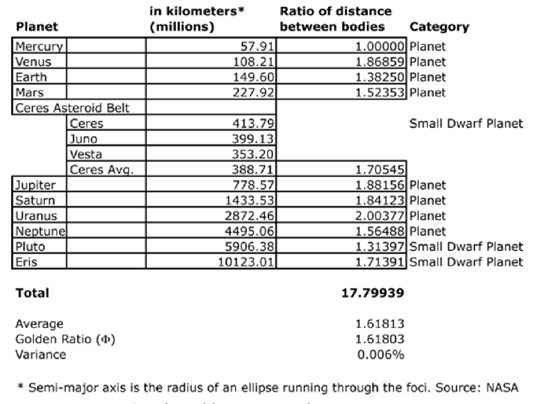
Thus, it is possible to use the same evolutionary Harmonic Lattice framework for life to explain the harmonic development of our solar system. (Fig 22).
Each Φ-spaced ring in the lattice can be described as an orthogonal or 90-degree location on a golden spiral. Since harmonic waves are most coherent and stable at right angles to one another, they would naturally entrain with a Φ-spiral as illustrated in the model. The original solar spiral continues to this day as the Sun’s heliospheric current sheet.
Just like the spirals of galaxies and other solar systems, counterbalancing spiral arms form as the pressure differential of gravity causes the space lattice to curve – triggering the Coriolis effect, starting rotation and polarizing the solar disc. Orthogonal to this disc, a toroidal pattern like the Polar Reflective Interference Model forms into the solar wind. All of this occurs according to universal harmonic laws, setting the stage for life.
In this way, we might extend the scope of evolution to include principles of resonance as they guide the solar system, bridging the study of cosmology with biology. Evolution is first and foremost a matter of harmonic patterning in a containment field, regardless of whether the container is a body or structured space. Darwinian theory is but a secondary process of adaptation to all this.
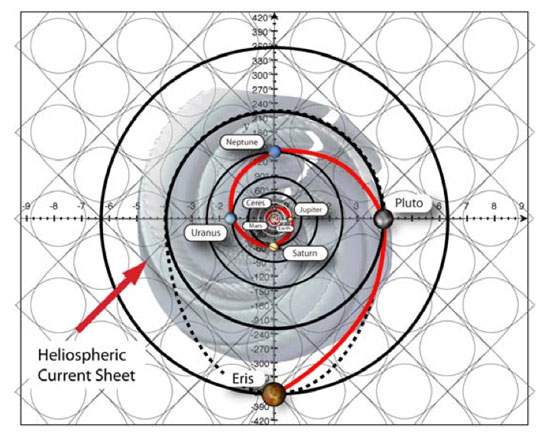
Perception as harmonic focusing function
One of the major shortcomings of Darwinian evolution theory is its inability to explain what caused inanimate matter to become animate. There is simply no fossil record of a trial and error process that explains how simple life ‘learned’ to develop sensory organs during a process of natural selection and random mutation.
Recent neurophysiological research is finding evidence that harmonic structures in the body provide an autonomous focusing function required by sensory organs. In vision cognition studies, the ‘Gaussian derivative model for spatial-temporal vision’ has been found to best describe the first stage of processing in our visual cortex for motion, orientation, location and size. [9] Similar studies of auditory cognition in cats and monkeys have also found a natural Gaussian derivative filter in the inner ear and auditory cortex that helps focus sound. [10, 11]
Together, these studies confirm the presence of a universal Gaussian derivative filter that helps mammals (and other biological life) identify and maintain attention on objects and sounds in the environment, a necessary skill for survival. As example, consider how a pitch-sensitive auditory filter would help identify the sounds of a predatory animal in time to flee. Or how it could help recognize the crying tones of offspring separated from the pack. In people, a Gaussian derivative filter in our auditory system is the reason we can recognize the pattern of concordant gaps in a musical octave and effortlessly follow the melody of a single instrument in an orchestra.
But since the Gaussian derivative distribution curve is just another name for the spectral interference pattern that harmonics make, these studies also tell us that we prioritize the world by focusing mostly on harmonic things. For instance, the Fibonacci spirals of our ears begin the focusing process of sound by ‘unwinding’ or canceling out fractional enharmonic frequencies to prepare sound for the eardrums. And since eardrums also happen to be shaped as a Polar Reflective Interference pattern with the inner ear bones positioned to measure maximum resonance and damping on the membrane, harmonic geometries are again emphasized out of the ocean of incoming sound.
As sound propagates further into the Basilar membrane of the ear’s spiraling cochlea, thousands of tiny hairs provide even more filtering by bending around the gaps that harmonics create. When you consider physiology as a prerequisite for cognition, the spiraling anatomy of the human ear evolved to reduce noise while enhancing recognition of harmonics. This must be why we can enjoy and respond emotionally to music. Simple music harmonies fit the coherent structure of our body like a glove.
Vision also has its harmonic filter. Around the fovea centralis, or ‘blind spot’ at the back of the eye, color cones self-organize according to something called a Gaussian density curve. Neurophysiologists use the Gaussian Color Model of hue, luminance and saturation to describe how our vision system interprets color as shapes. Few people realize that color actually helps us recognize objects in space and that everything we see is filtered and prioritized depending on how harmonically shaped it is. Thus, plants and animals with their reflective interference physiology are easily recognized and assume a higher priority to our eyes and ears than, say, a boulder or some artificially manufactured object.
In the most general sense, harmonics are a focusing property of Nature and should be central to any theory of evolution. The question is where does this process really begin and what causes it? What is the fundamental principle of evolution that focuses energy into life?
We can trace the harmonic evolution process back to the lattice structure of space itself as it first focuses light into particles, then particles into atoms and atoms into molecules. It is from the resonant atomic geometries of nucleotides that Hox genes in DNA know how to shape networks of other genes into specialized organs, probably communicated as concordant frequencies inside the circular field surrounding the fetus during gestation (Fig. 23).
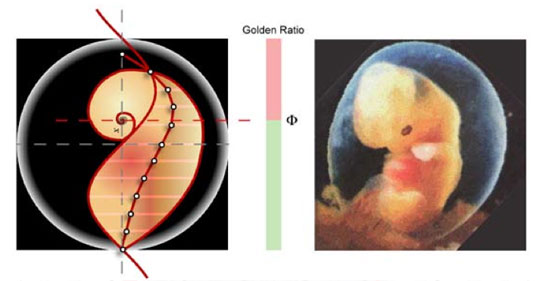
Some cells focus on extracting oxygen from the air; some on breaking down nutrients from food or eliminating waste; others on sensing the world around us and creating new life. All of this occurs as a kind of musical nesting process within the resonating container of the fetus.
In fact, the central goal of evolution – beginning with the very first primordial interaction between light and space – must be to focus energy into harmonically structured life forms that are able to recognize other harmonic forms. Counter to the widely accepted theory that life is a fluke of Nature and guided strictly by natural selection and random mutation, Darwinists need to seriously consider the idea that the universe is predisposed toward increasing coherence through the omnipresent patterning process of harmonic standing waves. Increasing coherence is built into the very fabric of spacetime even while entropy works to take it apart according to the second law of thermodynamics. The proof is all around us, as the following story illustrates.
One morning, a small woodland creature wakes up and begins his daily hunt for food. Somewhere else, a truck driver wakes up and gets ready to haul a new load down the highway. Stopping first for coffee and fuel, he enjoys the beautiful sunrise as he drives. But then, as he rounds the corner he sees a small animal in the road up ahead. With no time to react, he hits the innocent creature and in a tragic instant transforms him into another road kill statistic. Repeated over and over, this is the sad story of how vehicles kill an estimated one million vertebrate animals a day (one every 11.5 seconds) in the U.S. alone.
Yet while each road kill event appears to be just another random occurrence in a hostile and uncaring world, you might be surprised to learn that they all occur in a very predictable pattern. If we were to add up the distances between each of the road kill on the highway and sort them by distance inside a spreadsheet, we would find they tend to approximate a probability curve known as a Poisson distribution. The more road kill we measure, the closer it will fit into the same curve. And, if we could measure the road kill everywhere in the world at any given moment we would find an almost perfect match to the Poisson curve! How could this be?
As it happens, the Poisson distribution is a special case of the Gaussian distribution, which, as we know by now, is the spectral interference pattern of harmonics. So, this story is really telling us that the physics of harmonics is a guiding property of time – no matter how random something may seem. It is also telling us that the second law of thermodynamics, which defines entropy as the decaying (or damping) principle of Nature, should be amended to recognize the counterbalancing effect of reflective resonance in periodic systems. Harmony should not be ignored or avoided.
In the case of the woodland creature and truck driver, their very thoughts are guided by a universal harmonic pattern shared between their brains, which may in turn be locally synchronized by moving together through spacetime. While more experimental evidence is needed to prove such a claim, my own research and other recent studies do suggest this.
During the 1980’s, I was surprised to learn that brains operate together harmonically. While analyzing large libraries of electronic documents in a search engine I was working on (ironically named DARWIN for DAta Retrieval With INtelligence), my engineering team found that the frequency of word occurrences would always sort into a Poisson distribution. We found this to be true regardless of language or subject matter – even computer languages fit into the curve. It was just after this that it finally dawned on me that anything I or anyone else ever said or thought would always fall into this universal harmonic pattern after a minute or two, as long as it was semantically coherent.
So it is that each and every human brain thinks basically alike, expressing his or her thoughts through the shared harmonic pattern of language. As I pursued this line of inquiry in later years, I found many other studies to support it, including how neurons always fire in a Gaussian wave through the brain and how brain waves can be translated into musical harmonies for use in brain therapy. [12, 13, 14] The evolution of the brain must have been guided toward coherence over time by harmonic patterns in the overall body and the structure of space itself.
Consciousness as a Property of Spacetime
Perhaps the best evidence of Nature’s predisposition toward coherence is how starlight becomes a harmonic standing wave as it travels through space. While light leaves its source as a spread spectrum mix of electromagnetic radiation, it becomes more coherent and harmonic over time. This is due to the fact that as it travels through the quantum lattice of space, enharmonic frequencies are gradually suppressed and filtered out, leaving only harmonic frequencies in a single wave front. The farther the light travels from its source, the more it approaches the shape of a perfect plane or standing wave. Lasers work the same way.
As light bounces between two mirrors inside a laser cavity, it also travels a great distance through space. And just like starlight, the lattice structure of space filters out all fractional or enharmonic waves, thus ‘focusing’ the light into a single frequency wave. So, when laser light is released as a beam, it is really a powerful blast of harmonic wave partials riding on a single fundamental frequency of color much like a vibrating guitar string. And like a guitar string, laser harmonics can even be separated out by over- resonating whole number multiples of the fundamental frequency, as is often done these days to create exotic higher frequency lasers at a lower cost.
Now, since we can consider life to be a crystallized form of light, it too must become more coherent as it travels through space. We might even describe a living body to be a slow motion biological laser that focuses energy between its two reflecting halves; thus, becoming more harmonically tuned over time. When you think about it, a living being is just a resonating liquid crystal made mostly of carbon and water, becoming more coherent and more focused as it rides on the Earth through space.
From this perspective, spatial movement should really be considered the first principle of evolution, since it focuses (or grooms) life toward greater efficiency, greater mobility, greater balance, greater intelligence and ultimately greater consciousness. Like the gravitational pressure that ignites a star at a certain threshold of mass, logic tells us that it must be the movement of life through space that strikes the match of consciousness during the evolutionary process. From this spark of self-awareness, it is then the two reflecting halves of the brain (like mirrors in a laser) that holds the fire and keeps it burning.
One theory of the brain suggests that this reflective process creates a neurological hologram within which we recognize and interpret the world. Proposed in the 1980’s by neurosurgeon Karl Pribram in cooperation with quantum physicist David Bohm, holonomic brain theory describes cognition and memory as a holographic interference pattern produced by two coherent sources (two eyes; two ears) which act like lenses. Identical in principle to the interference patterns produced by a split-beam laser on holographic film, this theory describes cognition as a simple and efficient pattern matching process between the outside hologram of the world and the inside hologram of the brain. [15]
Extending this to include harmonic theory, we can explain how our brain measures and identifies objects through geometric proportions and pattern matching. In fact, each one of the principles of Gestalt psychology – continuity, regularity, simplicity, stability and unity – can be explained by the natural patterning of harmonic standing waves as they manifest in human physiology. The Reflective Interference Model, describing the physics underlying harmonic formations, provides a much-needed template for both holonomic theory and Gestalt psychology to describe how our brain interprets, measures and predicts the outside world.
But if our brain is a harmonic resonator made of light, focused into consciousness as it evolves in space and time, might the phenomenon of conscious self-awareness be a preexisting property of space? That is, could consciousness exist independent from physical life and simply be ‘tuned in’ by the resonant interaction of our liquid crystal brain with the quantum space lattice?
As incredulous as this may sound, the brain may not be much different from those old crystal radio sets back in the 1960s, picking up and transmitting certain frequencies through the quantum field of space based on principles of resonance.[16, 17] After all, as our brain thinks, quantum mechanics tells us that the electrons making up our thoughts are constantly taking ‘quantum leaps’ in and out of this spacetime. This suggests that our brain may be acting as a kind of quantum transceiver with our thoughts under the influence of non-local quantum effects.
According to quantum entanglement, thinking cannot be entirely local or physical, but instead able to exist anywhere in the universe or even outside of spacetime. The electrons of our thoughts do this by ‘tunneling’ across the so-called Higgs boson boundary into some other place millions of times a second, where they could be affected or influenced before returning. According to quantum physicist Evan Harris Walker, non-local quantum effects could determine how electrons group together on a particular set of neural synapses before firing OR inexplicably cause them to land elsewhere in the brain, leading to an entirely different thought. [18] So while our body and brain may be harmonic like everything else in the universe, our mind must resonate beyond spacetime.
All joking aside, human beings might simply be semi- autonomous biological robots under the remote control of a higher self. Given our current understanding of physics, it is really not that farfetched to think that we could be guided by impulses transmitted and received via quantum leaps from some other realm. Our concepts of free will, creativity and personality might well be a glimpse into this other realm, resonating through to us from space as subtle patterns in the liquid crystal antennae of our brains.
Harmonically Guided Social Evolution
As life evolved into reflective self-awareness, primitive tribal societies evolved into complex civilizations. Guiding this social evolution were the many physical archetypes of harmony and balance apparent in the natural world. Translated from abstract forces into the stories of personified musical-astrological gods and symbols, mankind first based its laws and governments on the physics of harmonics. Unified over 2,500 years ago by Pythagoras in a philosophy known as musica universalis, ancient civilizations found order and a noble purpose in harmonic science (Fig. 24).

Yet today, this musical theory of everything is nowhere to be found. The harmonic models of Nature no longer guide our understanding of how things came to be as they are or what their purpose might be. Instead, natural selection or divine intervention are the only reasons we give ourselves to explain the magnificent order and beauty we see around us. We live in a world defined by theories of creation and life that completely ignore the central role harmonics play in all things.
If mankind is to survive within a universe of natural laws, the truth of harmonic evolution must one day be rediscovered and accepted. When it is, the artificial barriers between biology, anthropology, psychology, acoustics, physics and all other fields of science will come tumbling down like the Berlin wall. Life will be seen as part of a whole and harmonically unified universe, falling under the purview of harmonic physics and described by musical philosophy. The quantum effects of subatomic harmonic systems will become central to all biological and medical research, leading the world toward any number of unimaginable advancements.
And as society’s thinking shifts, Western religion will change too, transforming into great temples of natural learning. The Gnostic study of sacred geometry and musical proportions will once again infuse our culture with a respect and appreciation for Nature. Everyone from the staunchest atheist to the most dogmatic fundamentalist will no longer deny the truth of a coherent, harmonically structured universe and the life inside it.
Today’s neo-Darwinian view that ‘restarting life on Earth (or another planet) would turn out completely different’ would be replaced by the deeper realization that 12:5 geometry is as much a universal constant as the circular resonance of π or the square damping action of the golden ratio, woven into the very fabric of space itself.
With the reintroduction of universal harmonic laws, we will also know that life is evolving in other harmonically balanced solar systems and that it cannot be too much different from our own. We will finally understand the cosmos as the purpose-driven incubator for life that it really is. Maybe then we will be ready to take the next critical step in Nature’s harmonic progression – peaceful coexistence.
8. Summary
We can no longer ignore the overwhelming proof of quantum effects on electrons and the established role of harmonic resonance and damping in the magnetic fields that contain them. Biologists and anthropologists alike need to accept these new truths and find a way to embrace them in their theories about life.
To make this happen, geneticists and physiologists must lead the way by acknowledging the importance of geometry, cymatics and the role of gravity in the structure of DNA and anatomy. Psychologists might also contribute to this new vision of life by considering the possibility that perception is first and foremost a function of physics and that consciousness likely operates beyond the brain under the influence of quantum effects. Change can only come when our most brilliant scientists and educators stop looking only for differences and begin looking for commonalities.
The greatest strength of Darwin’s theory of evolution is its ability to explain the diversity of life through random gene mutation and selection in a hostile environment. But this is also its greatest weakness since it cannot explain the commonality of life as found in the overwhelming presence of 5-fold endoskeletons and 3-fold exoskeletons in the fossil record. Only a theory founded on the physics of harmonics can explain this and provide a complete picture of how life evolved on Earth.
There are few absolutes in this world, but one of them is definitely the fact that a harmonic standing wave will always resonate into the same spectral interference pattern no matter what medium it travels through. Harmonic patterns truly are the grand scientific musical template for all coherent systems in Nature, repeated over and over in all things, especially life – yet, they remain completely ignored and written off as happenstance by modern evolutionary theory.
As long as this doctrine is in effect, people will never know what they have in common with the rest of Nature. As long as Darwin’s theory of evolution remains incomplete, so do we. Let us all open our minds to an evolutionary theory guided by the physics of harmonics, yet adapted to the environment. Ω
Selected Bibliography
1. Darwin C., ‘On the Origin of Species by Means of Natural Selection, or the Preservation of Favoured Races in the Struggle for Life,’ John Murray, London, 1859; Charles Darwin, Julian Huxley. The Origin of Species, Signet Classics, 2003. ISBN 0-451- 52906-5.
2. Fisher RA., ‘The Genetical Theory of Natural Selection,’ Clarendon Press, Oxford, 1930.
3. Williams GC., ‘Adaptation and Natural Selection,’ Oxford University Press, 1966.
4a. Chaplin MF., ‘Structuring and behaviour of water in nanochannels and confined spaces,’ In: Adsorption and Phase Behaviour in Nanochannels and Nanotubes, Dunne L, Manos G. (eds), Springer, 2009, article in press.
4b. Chaplin MF., ‘Roles of water in biological recognition processes,’ In: Wiley Encyclopedia of Chemical Biology, Begley TP. (ed), Wiley, 2008. DOI: 10.1002/9780470048672.
4c. Chaplin MF., ‘The memory of water; an overview,’ Homeopathy 2007;96:143-50 [Abstract];
4d. Chaplin MF. Reply to Comment on ‘The memory of water; an overview’, Homeopathy 2008;97:43-4.
4e. Chaplin MF., ‘A proposal for the structuring of water,’ Biophys Chemist 2000;83(3):211-21.
4f. Chaplin MF., ‘Water structuring at colloidal surfaces,’ In: Surface Chemistry in Biomedical and Environmental Science, Blitz J, Gun’ko V. (eds), NATO Security Through Science Series, Springer, 2006:1-10.
5. Merrick RS., ‘Interference: A Grand Scientific Musical Theory,’ (self-published), Fairview, Texas, 2009. ISBN: 978-0-615-20599-1.
6. White M., ‘The G-ball, a new Icon for codon symmetry and the genetic code,’ arxiv.org:q-bio/0702056v1 [q-bio.OT], Feb 26, 2007.
7. Yang CM., ‘On the 20 canonical amino acids by a cooperative vector-addition principle based on the quasi-20-gon symmetry of the genetic code,’ Neurochemistry and Physical Organic Chemistry Program, Nankai University, Tianjin, China, 2003.
8 Misner, CW, Thorne, KS, Wheeler, JA., ‘Gravitation,’ McMillan, 1997, ISBN: 0716703440, 9780716703440.
9. Young, R.A., Lesperance RM, Meyer, WW, (2001) ‘The Gaussian derivative model for spatial-temporal vision: I. Cortical Model,’ Spatial vision (Spat. vis.) ISSN 0169- 1015, 2001, vol. 14, no 3-4 (5 p.), pp. 261-319.
10. Fishman, Y.I., et. al. (2001), ‘Consonance and Dissonance of Musical Chords: Neural Correlates in Auditory Cortex of Monkeys and Humans,’ The Journal of Neurophysiology Vol. 86., No. 8, December 2001, pp. 2761-2788.
11. Cedolin, L. (2005), ‘Spatio-temporal representation of the pitch of complex tones in the auditory nerve,’ Eaton-Peabody Laboratory, Massachusetts Eye and Ear Infirmary, Massachusetts Institute of Technology.
12. Nardo E.D., Nobile A.G., Pirozzi E., Ricciardi L.M. (2007), ‘Natural Computing: an international journal archive,’ Volume 6 , Issue 3 (September 2007) table of contents, p283-310, 2007, ISSN:1567-7818
13. Cunningham J.P., Yu B.M., Shenoy K.V., Sahani M. (2008), ‘Inferring neural firing rates from spike trains using Gaussian processes’. In Advances in Neural Information Processing Systems 20, (J. Platt, D. Koller, Y. Singer, and S. Roweis, eds.), (Cambridge, MA), 2008, pp. 329-336.
14. Levin, Y.I. (1996), ”Brain music’ in the treatment of patients with insomnia,’ Neuroscience and Behavioral Psychology, Pringer New York, Vol. 28, No. 3, May 1998.
15. Bohm, D. (1980), ‘Wholeness and the Implicate Order,’ Routledge Classics 2002, ISBN: o-415-38978-5 (hbk).
16. Hadley, F., ‘Goodbye wires!,’ MITnews, June 7, 2007.
17. WiTricity home page: http://www.witricity.com/.
18. Walker, E.H. (2000), ‘The Physics of Consciousness: The Quantum Mind and the Meaning of Life,’ Basic Books (December 2000), ISBN: 978-0738204369.
Further Reading
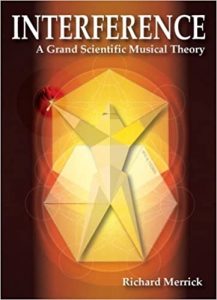 Interference – A Grand Scientific Musical Theory, By Richard Merrick
Interference – A Grand Scientific Musical Theory, By Richard Merrick
Content courtesy of Richard Merrick
Copyright (c) 2011. All Rights Reserved.
http://www.interferencetheory.com/









